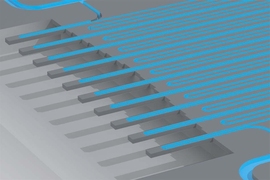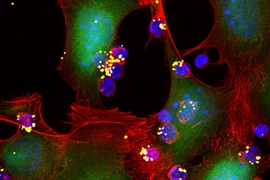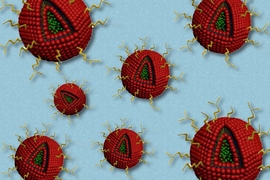Cancer Research UK awarded $7.9 million to MIT researchers as part of an international team to identify combinations of drugs that could effectively tackle glioblastoma — the most aggressive and deadly type of brain tumor. The team will then use tiny “Russian doll-like” particles — a technology developed at MIT — to deliver those combinations to brain tumors.
The MIT team, based at the Koch Institute for Integrative Cancer Research, includes Paula Hammond, the David H. Koch Professor of Engineering and head of the Department of Chemical Engineering; Michael Yaffe, the David H. Koch Professor of Science and director of the MIT Center for Precision Cancer Medicine; and Forest White, the Ned C. and Janet Bemis Rice Professor of Biological Engineering.
Brain tumors represent one of the hardest types of cancer to treat. There are just a few drugs approved to treat glioblastoma, but none of them are curative. Just last year, around 24,200 people in the United States were diagnosed with brain tumors, with around 17,500 deaths from brain tumors in the same year. Patients diagnosed with disease have a median life expectancy of less than 15 months.
Treating glioblastoma is challenging in part because, like many other cancers, it can quickly develop resistance to cancer drugs. Some drug combinations deliver a powerful one-two punch that can overcome cancer cells’ ability to adapt to treatment.
The international team aims to find potential drug combinations and targets using high-throughput small molecules and CRISPRi-based screens, mass spectrometry proteomic analysis, and computational modeling platforms for systems pharmacology developed at MIT for predicting the development and reversal of drug resistance in glioblastomas. The team will then test the effectiveness of newly-identified drug combinations in cell and mouse models, including two promising combinations already identified by researchers at the Koch Institute and the University of Edinburgh.
Drugs that have already been approved, as well as experimental drugs that have passed initial safety testing in people, will be prioritized. Because of this, if an effective drug combination is found, the team won’t have to navigate the initial regulatory hurdles needed to get them into clinical testing, which could help get promising treatments to patients faster.
But glioblastoma presents an additional obstacle to treatment: Even if the researchers find potential new treatments, the drugs must cross the blood-brain barrier, a structure that keeps a tight check on anything trying to get into the brain, drugs included. The team will deploy nanoparticles developed by Hammond at MIT to ferry new drug treatments across this barrier. The nanoparticles — one-thousandth the width of a human hair — are coated in a protein called transferrin, which helps them cross the blood-brain barrier.
Not only are the nanoparticles able to access hard-to-reach areas of the brain, they have also been designed to carry multiple cancer drugs at once by holding them inside layers, similarly to the way Russian dolls fit inside one another.
To make the nanoparticles even more effective, they will carry signals on their surface so that they are preferentially taken up by brain tumor cells. This means that healthy cells should be left untouched, which will minimize the side effects of treatment.
Early research by the Hammond and Yaffe labs has already shown that nanoparticles loaded with two different drugs were able to shrink glioblastomas in mice.
“Glioblastoma is particularly challenging because we want to get highly effective but toxic drug combinations safely across the blood-brain barrier, but also want our nanoparticles to avoid healthy brain cells and only target the cancer cells," Hammond says. "We are very excited about this alliance between the MIT Koch Institute and our colleagues at Edinburgh and Oxford to address these critical challenges.”
The MIT group and their collaborators in the UK are one of three international teams to have been given Cancer Research UK Brain Tumor Awards — in partnership with The Brain Tumour Charity — receiving $7.9 million of funding. The awards are designed to accelerate the pace of brain tumor research. Altogether, teams were awarded a total of $23 million.
“The Cancer Research UK Brain Tumor Award provides us with a unique opportunity to unite perspectives in biology and engineering to create better options for patients with glioblastoma,” says Yaffe. “Each member of this international team brings a deep well of expertise— in the biology of brain tumors, signaling proteomics, high-throughput screening, drug combinations and systems pharmacology, and drug delivery technologies — that will be vital to overcoming the challenges of developing effective therapies for glioblastoma.”
This article has been updated to reflect additional specificity regarding the project and its collaborators.









